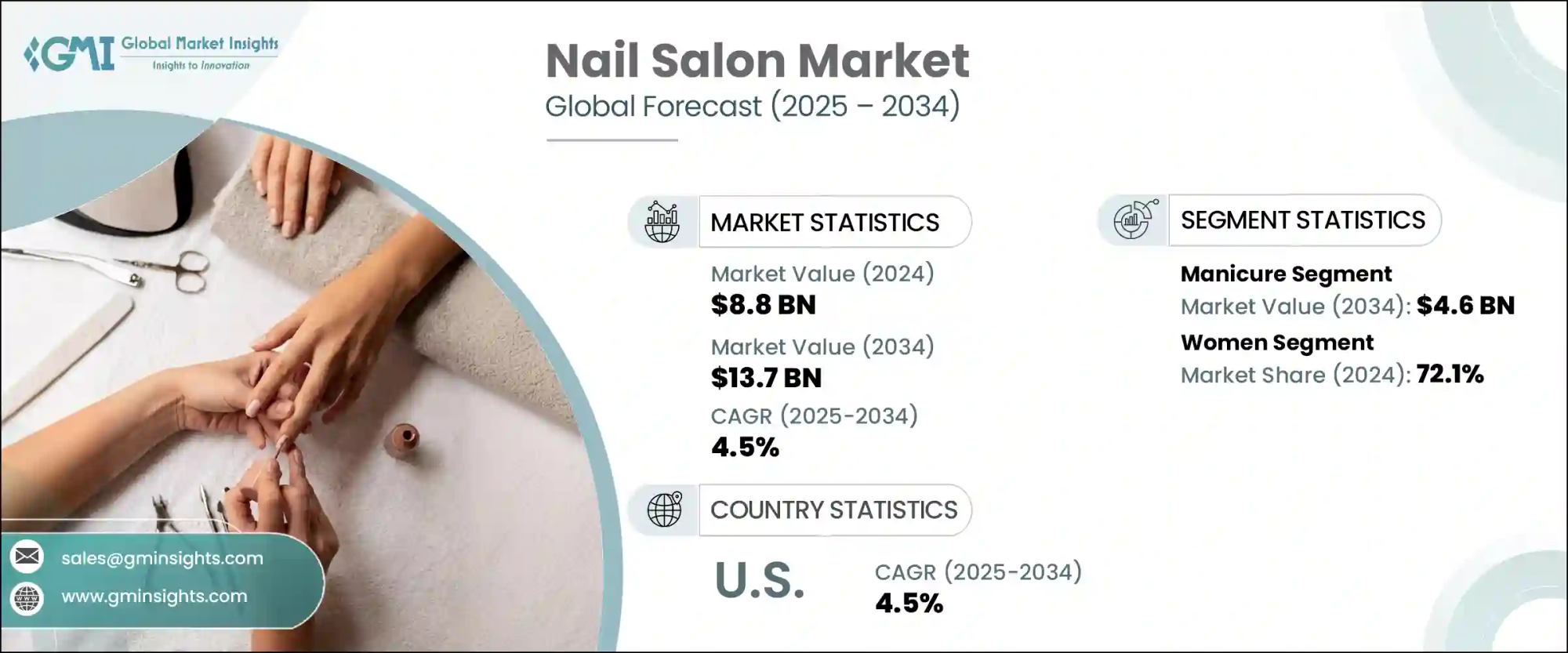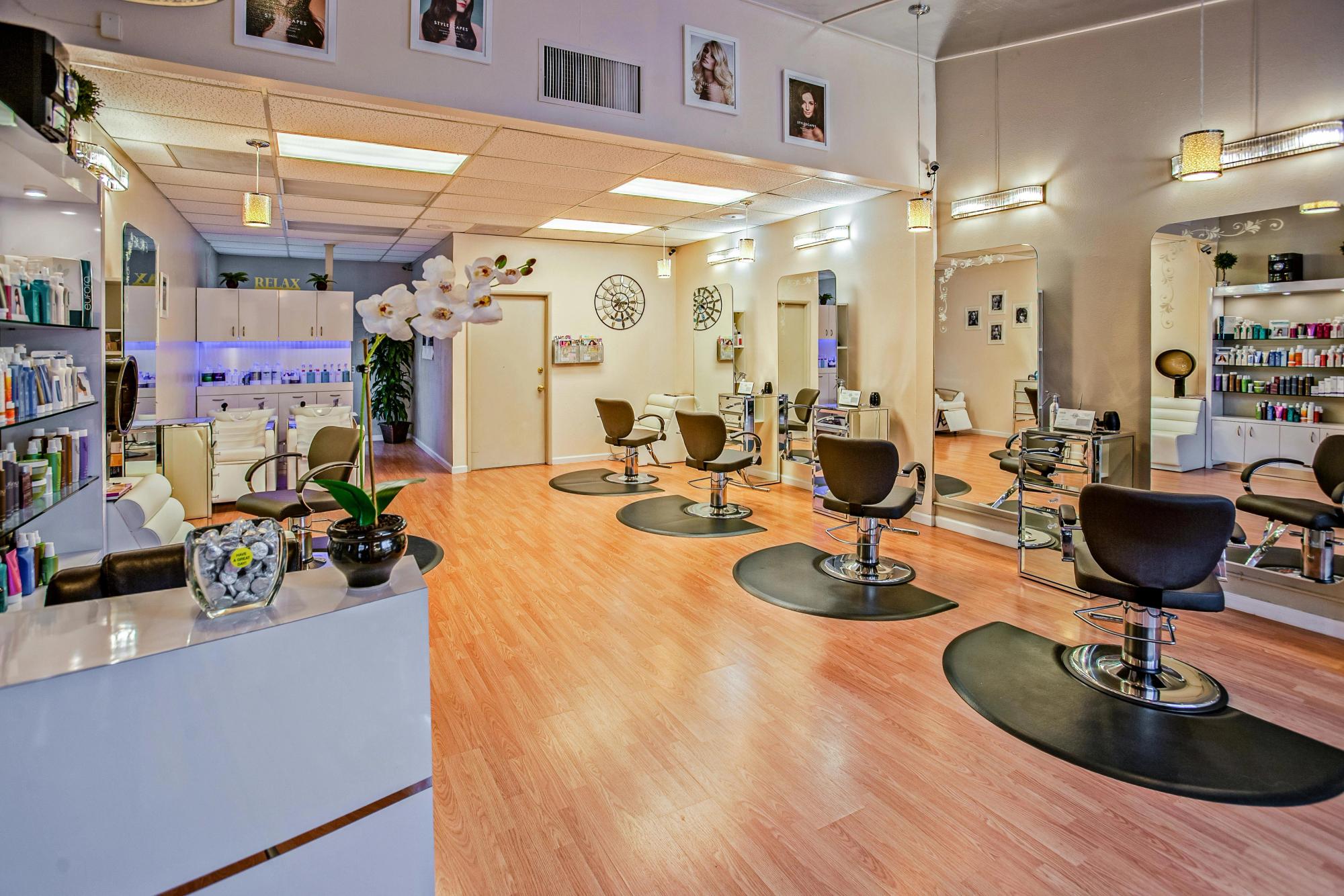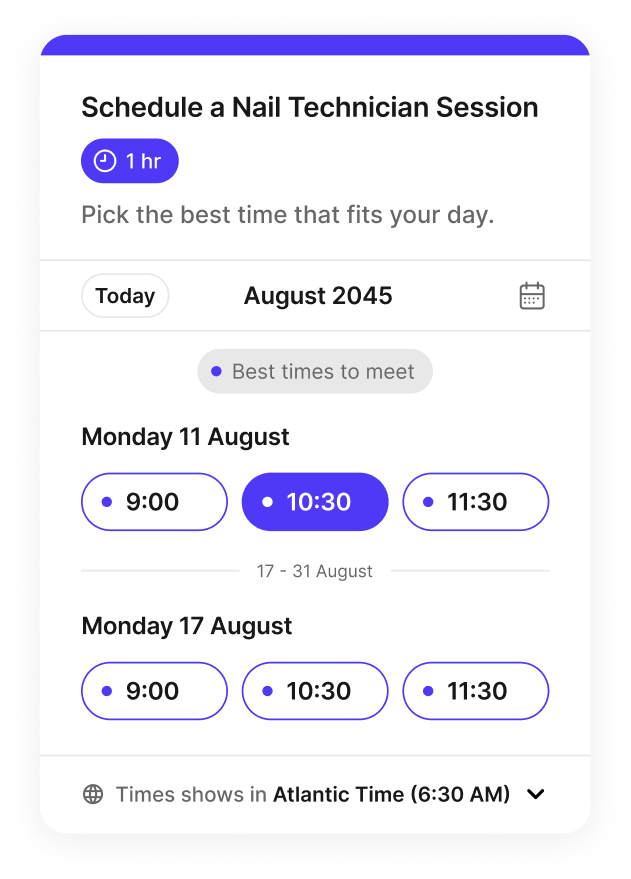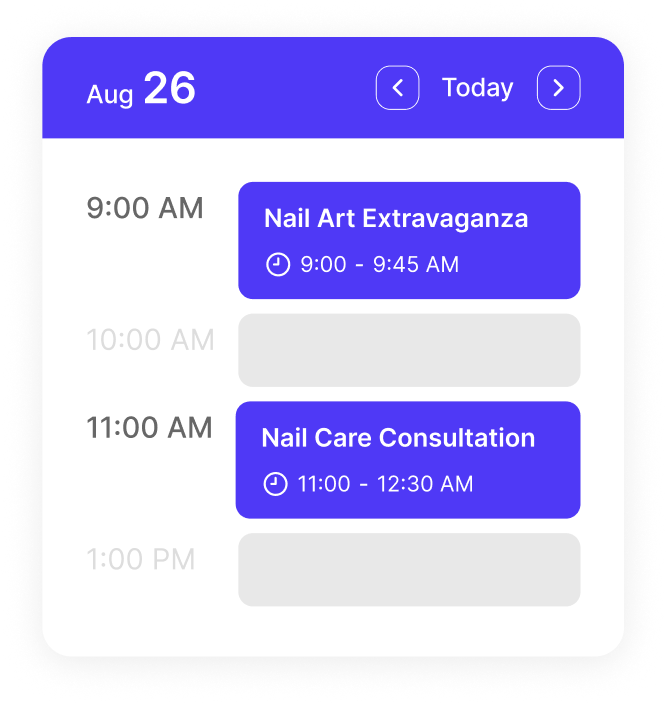So, you're dreaming of opening your own nail salon? Go you!
You're not just dreaming of beautiful design; you're building a profitable business that gives you control. If the startup phase feels overwhelming, don’t worry. We’ve cut through the stress to give you the clarity you need to launch a smart, successful salon in 2025.
In this helpful overview, you’ll learn the three keys to a successful launch:
- Money and budgeting: A clear breakdown of your start-up costs, from the initial $25,000+ investment to recurring monthly expenses.
- Paperwork and legal: Considerations for getting the right licenses and protecting your business.
- Low-chaos operations: How to define your profitable niche, hire a dream team, and eliminate scheduling headaches with the right booking tools.
Let's turn your passion into a smart, successful enterprise.
Why opening a nail shop is a smart move in 2025 (and beyond)
If you’re considering opening a nail salon, here’s some good news: The nail care market is booming. Valued at $8.8 billion in 2024, it shows consistent growth, projected at a compound annual growth rate (CAGR) of 4.5% over the next decade.

Simply put, people want your services!
Pro Tip: Focus on smart differentiation. Standard manicures are often high-volume, low-margin, which is great for building volume. However, the best way to thrive is to find a profitable niche.
Conduct local research to see if your market supports advanced, higher-margin services. Clients are often willing to pay a premium for advanced services (like sculpted gel extensions or intricate nail art) or health-conscious options (like organic, non-toxic products).
Differentiating your service menu helps you stand out from the competition and justify higher prices, making your business more recession-proof. It all starts with knowing what your neighborhood wants!
Defining your nail salon’s target client and niche
Don't try to serve everyone, that just makes it harder to stand out. When you choose a specific niche, you make marketing easier (and justify higher prices).
Think about your ideal client, and how you can appeal to them. Here are some ideas:
- The busy professional: Your niche is speed, efficiency, and flawless online booking. Payoff: High turnover and loyalty based on reliability.
- The wellness advocate: Your niche is non-toxic polishes, superior ventilation, and spa-level relaxation. Payoff: Premium pricing and clients who prioritize health over cost.
- The trend setter: Your niche is high-end, custom artistry, and social media buzz. Payoff: Strong visual branding that draws in clients seeking unique experiences.
See how specializing can help you stand out and drive better results for your business?
Writing a comprehensive business plan for your nail bar
Your business plan is your roadmap to avoiding common startup mistakes. It’s an essential document for securing funding, but it also helps you see potential pitfalls before they happen.
Essential business plan components
A great business plan is clear, concise, and compelling. It should include:
- Executive summary: The "elevator pitch" for your entire business. Make it strong.
- Example: "Luxe Nails will be a premium, appointment-only nail studio located in the high-foot-traffic Midtown district. We specialize in non-toxic, sculpted gel extensions and offer a best-in-class client experience. We project profitability within 18 months, driven by an average ticket of $85 and a strong client retention strategy.”
- Services and pricing: A detailed menu that shows exactly how you’ll generate revenue.
- Market analysis: Prove you understand your local area, your competitor pricing, and why your niche fills a demand.
- Operational strategy: Detail how the salon will run day-to-day, from cleaning to client flow.
- Financial projections: The non-negotiable section. This must show your startup budget, a clear break-even point, and projected profit/loss for the first three to five years.
Securing financial backing
Once your business plan for your nail salon is ready, you’ll be prepared to approach financial partners confidently.
Our recommendation is to work with an accountant or financial advisor early on to decide which path is best for your business. They can provide tailored advice on the common funding avenues that may be available to you, like SBA loans, bank loans, or grants.
Nail salon start-up costs and budget breakdown
Let's talk money.
Many people, salon and beauty business owners included, underestimate the costs of starting up. And that can lead to early stress. We don’t want that.
Ahead of launching your nail salon biz, be prepared for a substantial initial investment, primarily driven by real estate, build-out, and specialized equipment.
Your initial investment could range widely, typically from $25,000 for a small, simple space to over $150,000 for a high-end salon.
One-time salon start-up expenses
These are the costs that get your doors open, including the items needed to start a nail salon.
| Expense category | Estimated cost range (USD) | Considerations |
| Lease deposit & first month's rent | $2,000 – $20,000+ | Depends on location |
| Renovation, build-out & design | $15,000 – $30,000+ | Includes plumbing for pedi chairs and crucial ventilation systems |
| Equipment & furniture | $8,000 – $25,000 | Pedi chairs, manicure tables, UV lamps, reception desk |
| Initial supplies & inventory | $2,000 – $5,000 | Your first stock of polishes, gels, and disposables |
| Legal, permits, and licensing fees | $2,000 – $4,500 | Business formation, state licenses, health permits |
| Total estimated startup (excl. rent/renovation) | $25,000 – $80,000+ |
One thing you might consider is whether to buy your own equipment and furniture or to lease. To help make your decision, here’s a quick overview of the pros and cons for each:
| Decision | Pros (why It works) | Cons (why It doesn't) |
| Buying new equipment | Ownership: You build equity and can resell the items later. Customization: You get exactly what you want (color, brand, features). | High up front cost: Significantly increases your initial startup budget (the $25,000+). Depreciation: Equipment loses value immediately. |
| Buying second-hand equipment | - Major cost savings (often 30–70% cheaper) - Great for startups on a tight budget - Can help you allocate more money to design, marketing, or premium services | - May lack warranty - Potential wear/tear or hidden defects - Limited customization & style options |
| Leasing equipment | Low initial cost: Preserves your working capital for inventory and operations. Modernity: Easier to upgrade to new chairs/curing lamps when technology advances. | Long-term cost: You usually pay more in total than if you had bought the equipment outright. No equity: You don't own the asset at the end of the lease. |
Recurring monthly operating expenses
| Expense category | Estimated monthly cost (USD) | Considerations |
| Rent & utilities | $640 to $4,000+ | Utilities (power, water, A/C) can be significant. This range depends heavily on your salon's size and client volume. |
| Payroll | Variable (Highest Cost) | This is the money you pay your staff each month and is typically your largest recurring expense. |
| Inventory Restock | $500 to $1,500 | Budget this amount to keep your shelves stocked with high-quality products and essential nail salon kit. |
| Insurance Fees | $42 to $125 | General liability insurance usually runs $500 to $1,500 per year, which breaks down to a monthly range. |
| Total (Excl. Payroll) | $1,182 to $5,625+ | This range covers all fixed operating costs. Be sure to factor in Payroll separately, as it will significantly increase this total. |

Essential nail salon equipment (with approximate costs)
| Equipment | Description | Approx. Cost (USD) |
| Autoclave | Medical-grade tool sterilizer (250°F / 120°C steam). Required in many states | $2,000 – $3,000 |
| Barbicide | EPA-registered disinfectant for metal tools & surfaces | $25 – $100 |
| UV sterilization cabinet | Keeps sterilized tools clean between clients (not a replacement for autoclave) | $80 – $300 |
| Nail drill bits | Carbide/ceramic/diamond bits + sanding bands | $10 – $150+ per bit/set |
| Precision nail clippers | For trimming thick/damaged nails safely | $15 – $60 |
| Cuticle pushers | Stainless-steel tools for pushing back cuticles | $10 – $30 each |
| Cuticle scissors | Sharp scissors for trimming non-living tissue | $20 – $50 each |
| Shaping nail files (80–180 grit) | Used for acrylic/builder gel shaping. Usually single-use | $5 – $15 each |
| Finishing files (240+ grit) | Smooth and refine natural nails | $3 – $10 each |
| Buffing blocks | Pre-polish buffing and smoothing | $2 – $8 each |
| Fingernail clippers | Smaller, curved blades for precise trimming | $10 – $25 |
| Toenail clippers | Larger, reinforced clippers for thick nails | $20 – $50 |
| Nail art/builder brushes | Gel, acrylic, detail, ombré brushes | $15 – $120+ |
| LED manicure table lighting | Adjustable, shadow-free lighting for precision | $100 – $300 |
| Manicure table (with LED options) | Workstation with storage + ventilation optional | $150 – $800 each |
| Pedicure chair | Plumbed or portable, with a basin + massage features | $600 – $6,000 |
| Technician stools | Adjustable ergonomic seating | $50 – $200 |
| Reception desk | Front-of-house check-in station | $200 – $1,000+ |
| Storage cabinets & shelving | For tools, polishes, towels, sanitation logs | $100 – $500 |
Licensing, permits, and legal structure for your nail services
Ready for the next step? Let’s tackle the paperwork.
Compliance is the foundation of a successful business. Nail salons are heavily regulated by state boards, so you must get this right from day one.
Essential licenses and permits
Your state and county require several documents before you can legally operate:
- Business Operating License: Your city/county permit to operate commercially.
- Salon Establishment License: This is crucial. It’s issued by the state cosmetology board and requires a successful health and safety inspection of your physical space.
- Certificate of Occupancy (C of O): Required after any construction. It verifies your space meets safety, fire, and zoning codes.
- Individual technician licenses: Ensure every single person touching a client is currently and properly licensed in your state. (Pitfall to avoid: Assuming booth renters handle this. It's ultimately your salon's responsibility.)
The exact permits and licenses you need may differ depending on your state or city. Check with the relevant department in your location to be sure you have the right ones.
Protecting yourself: legal and insurance requirements
Before you open your doors, you must establish a legal structure for your business and secure proper insurance. Getting this right from the start is how you protect your assets and set the foundation for a stress-free business.
For example, Progressive offers a dedicated “Nail Salon & Nail Technician Insurance” solution covering general liability, professional liability and a business owner policy (BOP) for salon owners and techs. Also, The Hartford provides tailored “Nail Technician & Salon” insurance that addresses risks such as client injury, equipment damage and salon liability.
We strongly advise talking to a small business lawyer or a financial consultant. They will help you review and make final decisions on key topics, including:
- Legal structure: Determining the best legal entity for your business (e.g., Sole Proprietorship, LLC).
- Essential insurance coverage: Securing the right policies, such as general liability and professional liability, to protect you from common risks.
Getting expert advice means you can be sure you’re protected, and can focus on delivering great service to your customers.
Alternative business models
Opening a traditional salon isn’t the only path to success. Depending on your budget, lifestyle, or long-term goals, these models can offer more flexibility, and in some cases, higher profits.
1. Nail suite rental (Independent contractor model)
- You rent a small private studio inside a beauty suite facility
- You set your own hours, pricing, branding, and services
- Perfect for: Established techs with loyal clients and a desire for independence
- Pros: Low overhead, high creative freedom, more privacy for clients
- Cons: You’re responsible for all supplies, equipment, licenses, and marketing
2. Mobile nail tech (In-home services)
- You travel to clients’ homes, hotels, offices, or nursing facilities
- Requires a portable setup and excellent time management
- Perfect for: Techs who want a low-cost start-up and a premium niche
- Pros: Ultra-low overhead, can charge premium for convenience
- Cons: Travel time reduces the number of daily appointments; setup varies by location
3. Event-based services (weddings, photo shoots, corporate events)
- You provide on-site services for groups or productions
- Think: bridal parties, influencer shoots, runway, or backstage work
- Perfect for: Techs skilled in creative design, long-wear manicures, and flawless finishes
- Pros: High hourly rates, excellent for networking, often booked well in advance
- Cons: Irregular scheduling and travel — often weekends, evenings, or early mornings
4. Group rental (Splitting a space with other techs)
- Share a commercial space and divide rent, utilities, furniture, and maintenance costs
- Each tech may operate as an independent contractor
- Perfect for: Friends/colleagues who want a salon feel without the solo cost
- Pros: Lower overhead, shared responsibilities, easier to launch
- Cons: Must align on cleanliness, scheduling, and brand standards

Typical profit margins in the nail industry
Understanding profit margins helps you plan realistically and price your services correctly.
Here’s what new and established nail businesses typically see:
Average profit margins
| Type of operation | Typical profit margin |
| Traditional nail salon | 10% – 25% |
| Nail suite (solo tech) | 40% – 60% |
| Mobile nail tech | 50% – 70% |
| Event-based nail services | 60% – 80% |
Note: Data from Business Dojo reports 15-25% as a typical net margin, while “well-managed salons in prime locations can achieve margins of 30-40%” for a traditional nail salon. The 40%-80% margin above is derived from logic (lower overhead), not from strong empirical data, so margins may vary.
Why margins vary:
- Traditional salons have higher overhead: rent, staff wages, payroll taxes, utilities, insurance
- Solo suite renters keep most of the revenue but must buy all supplies and do their own admin
- Mobile techs have low overhead but higher travel time
- Event-based techs charge premium rates for specialized or on-call services
Ways to increase margins:
- Offer premium-priced services (structured gel, nail art, builder gel overlays)
- Sell retail products (cuticle oils, aftercare kits)
- Use smart scheduling tools (like Koalendar) to reduce no-shows and fill your calendar
- Focus on client retention, not just acquisition
Staffing, training, and salon culture
The hardware is purchased, and the licenses are in hand. Now, the fun part: building a team that shares your vision. Don't stress, we've broken down the hiring process into simple steps.
Your team is your profit engine. A happy, efficient staff equals loyal, returning clients.
Hiring your dream team
When hiring, prioritize attitude and reliability over just technical skill. Skills can be taught; reliability cannot.
Here’s a quick checklist for hiring:
- Skills assessment: Test their core skills (clean cuticle work, smooth polish application).
- Customer service interview: Can they talk to clients? Are they friendly and engaging?
- Culture fit: Do they align with your salon's professional standards and atmosphere?
Compensation and control
How you staff your salon is one of the most critical decisions you will make. It determines your overhead, your control over the brand, and your scheduling flexibility.
Decide on your model early:
- W2 employees: You pay wages/commission and control their schedule, training, and service quality. The benefit: Consistent, high-quality service across the board.
- Booth renters (1099): They pay you rent. They manage their own schedule and clients. The benefit: Lower payroll burden, but less control over your brand and sanitation standards.
Need more information? Check out this detailed comparison on W2 Employees vs. 1099 independent contractors in the salon industry.
The power of continuous training
The industry changes fast. Invest in your staff’s education on new trends (e.g., structure gel, advanced shaping) and mandatory refreshers on health board sanitation rules. When you invest in them, they invest in your business.
Marketing and client acquisition strategy
You need to create a buzz that makes clients excited to book that first appointment. Your marketing strategy should be visual, targeted, and always lead directly to your booking link.
Digital presence: your visual portfolio
The beauty industry lives on visuals. Your social media is your portfolio. Here’s how to market your work and get client bookings.
- Instagram and TikTok: Post only high-quality, professional photos of your best work. Use strong lighting and consistent filters to build a recognizable brand aesthetic.
- Direct booking link: Include your Koalendar booking link in your social media bios and on your website (and make it easy to see!). Don’t make potential clients hunt for a phone number.
- Local SEO: Claim your Google Business Profile (GBP). Ensure your services, hours, and photos are always updated. Focus on getting client reviews, as these are gold for local rankings and helping you get found.
- Fill chairs with discounts: Keep those chairs full! Set up coupons or seasonal deals to encourage rebookings and get clients through the door during slower weeks.
Retention marketing (the profit driver)
Acquisition is expensive; retention is cheap. Try these tips to build a loyal client base.
- Loyalty programs: Reward clients who book regularly (e.g., the 10th manicure is half price).
- The follow-up: Use a gentle email follow-up a week after their service to check on their nails and prompt their next booking via their personalized Koalendar link.
- Grand opening event: Offer a free premium add-on (like a hydrating mask or specialty oil) to the first 50 clients who book and pay a deposit through your Koalendar link.
Financial management and profitability
Profitability boils down to two things: maximizing your service ticket and utilizing every available hour in the salon.
Pricing strategy: know your worth
If you offer premium service, charge premium prices. Your pricing must cover overhead, payroll, product, and a healthy profit margin.
Here are some tips to boost your balance sheet:
- Tiered menu: Offer good, better, and best versions of every service. This naturally encourages upselling.
- Retail revenue: Stock high-quality products (cuticle oil, hand creams) that complement your services. Retail is high-margin income that happens without using a chair.
Key performance indicators (KPIs) to monitor
Track these numbers to understand your business health and performance:
- Average service ticket: The total value of an average client visit. (Goal: always increasing.)
- Occupancy rate: The percentage of available technician time that is actually booked. (This is where smart scheduling with Koalendar directly impacts profit; higher efficiency equals higher occupancy.)
- Client retention rate: The percentage of clients who return within a specified time frame.
Booking, scheduling and running smoothly
This is the key to running your business instead of letting it run you. The single largest stress point in any salon is scheduling; missed appointments, constant phone calls, and double-bookings.
Let’s be honest: you didn't open a nail salon to spend your time playing phone tag and chasing no-shows. You deserve to focus on the art and the clients right in front of you.
A reliable booking automation tool can help reduce the admin chaos, so your staff can spend more time doing billable work.
When you implement the right tool, you get your focus back. Koalendar is one scheduling platform that acts as that operational safety net.
Koalendar’s scheduling software for nail salons means you can accept bookings and fill your schedule without wasting time on admin.

- Streamline client and staff management: Koalendar is everything you need in one simple, mobile-friendly platform. It connects instantly with Google, Outlook, and iCloud to guarantee zero double-bookings. It also allows clients to book, reschedule, or cancel appointments 24/7 from their phones or desktops. For your team, you can easily assign appointments, manage shifts, and even set up a system to rotate bookings evenly across your technicians.
- Protect your time and revenue: No-shows and last-minute cancellations are a massive drain on profit and morale. Automated SMS and email reminders drastically reduce no-shows. For even greater security, set up payment integration to require deposits or full upfront payment. With support for 20+ payment methods, you secure the booking and protect your revenue stream immediately.
- Ensure a perfect, prepared appointment: Eliminate guesswork and surprises before a client sits down. Use custom booking forms to collect details about their current nails (semi-permanent, refill, etc.) or even inspiration photos before they arrive. Plus, use the built-in analytics to track bookings, cancellations, and revenue trends, so you always know which services are most popular and where to focus your energy to grow smarter.

Rachel Daily, Co-Founder and Co-Owner of Cure Studios, says: “Once you start operating your salon, you realize you can use software to optimize your entire business and create meaningful and lasting client relationships. So, don’t think about technology as a box to be checked. Think about it as something that can provide a significant competitive edge.”
Koalendar can be that perfect assistant for your new salon.
Opening your own salon? Time to nail it!
Seriously, starting a nail salon is a huge deal, and you should be proud of taking this leap!
We know it feels like a massive undertaking, but here’s the secret: success isn’t about perfect wall colors or fancy chairs. It’s about the experience, making every client feel relaxed and taken care of, from the moment they book until they walk out the door.
If you’re taking the first steps to open a nail salon, this guide provides a general overview of things to take into consideration.
An operational tool like Koalendar is such a game-changer. It instantly removes the biggest headache in your day: the scheduling chaos.
Get started with your nail salon booking software for free today, no credit card needed!
When Koalendar handles the bookings, the reminders, and the calendar juggling, you get your focus back. You can finally spend your energy on the things that truly light you up and grow your business: delivering great service and building those lasting client relationships.
Take a deep breath. You’ve got this! Your plan is solid, and you've got the right tools to make it happen without the stress.






